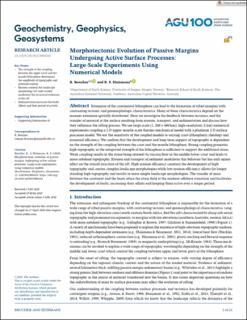| dc.contributor.author | Beucher, Romain | |
| dc.contributor.author | Huismans, Ritske | |
| dc.date.accessioned | 2021-08-05T12:53:27Z | |
| dc.date.available | 2021-08-05T12:53:27Z | |
| dc.date.created | 2021-03-02T21:55:16Z | |
| dc.date.issued | 2020 | |
| dc.identifier.issn | 1525-2027 | |
| dc.identifier.uri | https://hdl.handle.net/11250/2766546 | |
| dc.description.abstract | Extension of the continental lithosphere can lead to the formation of rifted margins with contrasting tectonic and geomorphologic characteristics. Many of these characteristics depend on the manner extension spatially distributed. Here we investigate the feedback between tectonics and the transfer of material at the surface resulting from erosion, transport, and sedimentation and discuss how they influence the rifting process. We use large-scale (1,200×600 km), high-resolution (1 km) numerical experiments coupling a 2-D upper-mantle-scale thermo-mechanical model with a planform 2-D surface processes model. We test the sensitivity of the coupled models to varying crust-lithospheric rheology and erosional efficiency. We confirm that the development and long-term support of topography is dependent on the strength of the coupling between the crust and the mantle lithosphere. Strong coupling promotes high topography as the integrated strength of the lithosphere is sufficient to support the additional stress. Weak coupling results in the stress being relaxed via viscous flow in the middle/lower crust and leads to more subdued topography. Erosion and transport of sediment modulates this behavior but has only minor effect on the overall structure of the rift. High erosion efficiency counters the development of high topography and creates complex landscape morphologies while low erosion efficiency allows for longer standing high topography and results in more simple landscape morphologies. The transfer of mass between the continent and the basin alters the stress field at the onshore-offshore transition and facilitates the development of faults, increasing their offsets and keeping them active over a longer period. | en_US |
| dc.language.iso | eng | en_US |
| dc.publisher | AGU | en_US |
| dc.rights | Navngivelse 4.0 Internasjonal | * |
| dc.rights.uri | http://creativecommons.org/licenses/by/4.0/deed.no | * |
| dc.title | Morphotectonic Evolution of Passive Margins Undergoing Active Surface Processes: Large-Scale Experiments Using Numerical Models | en_US |
| dc.type | Journal article | en_US |
| dc.type | Peer reviewed | en_US |
| dc.description.version | publishedVersion | en_US |
| dc.rights.holder | Copyright 2020 The Authors | en_US |
| dc.source.articlenumber | e2019GC008884 | en_US |
| cristin.ispublished | true | |
| cristin.fulltext | original | |
| cristin.qualitycode | 2 | |
| dc.identifier.doi | 10.1029/2019GC008884 | |
| dc.identifier.cristin | 1895103 | |
| dc.source.journal | Geochemistry Geophysics Geosystems | en_US |
| dc.identifier.citation | Geochemistry Geophysics Geosystems. 2020, 21 (5), e2019GC008884. | en_US |
| dc.source.volume | 21 | en_US |
| dc.source.issue | 5 | en_US |

